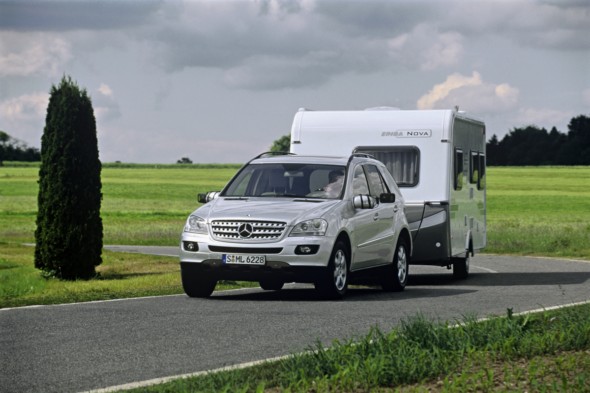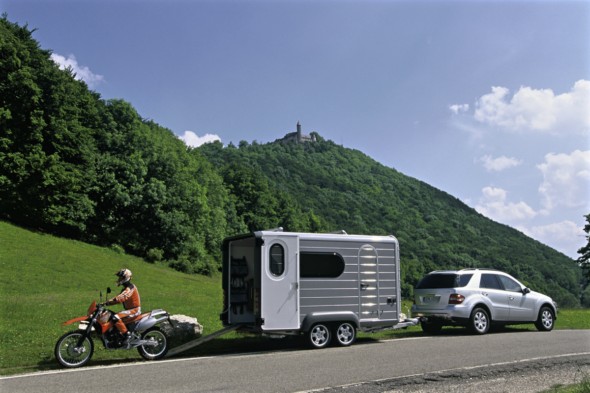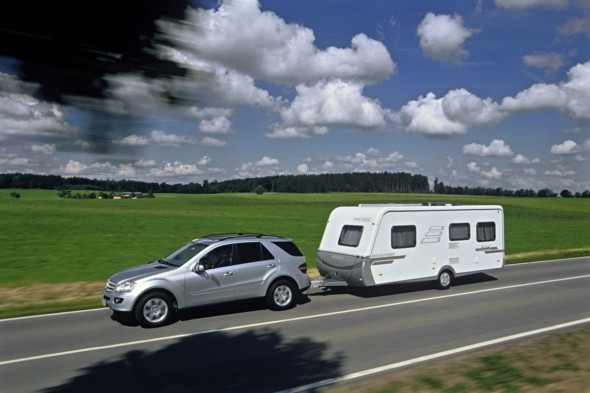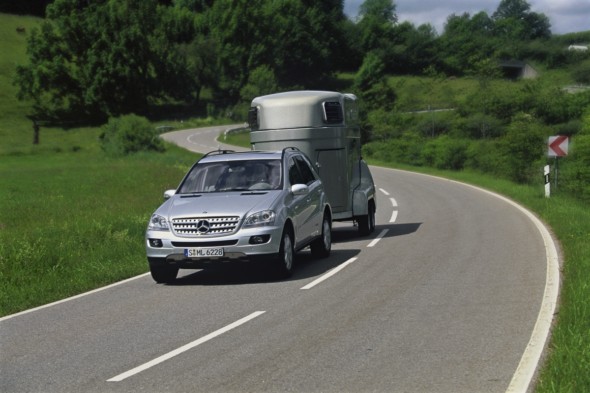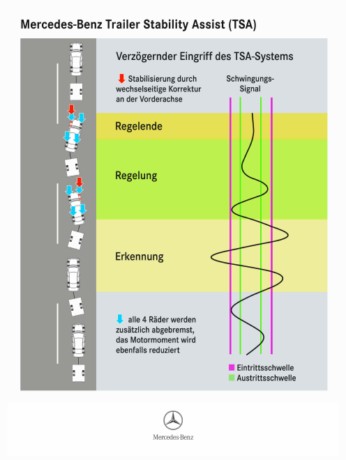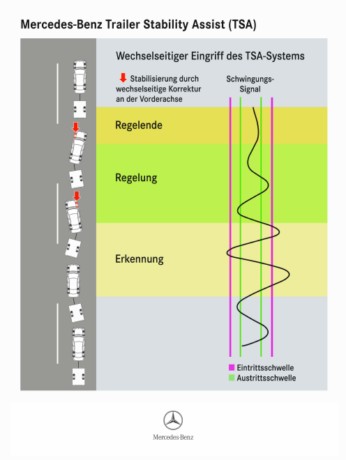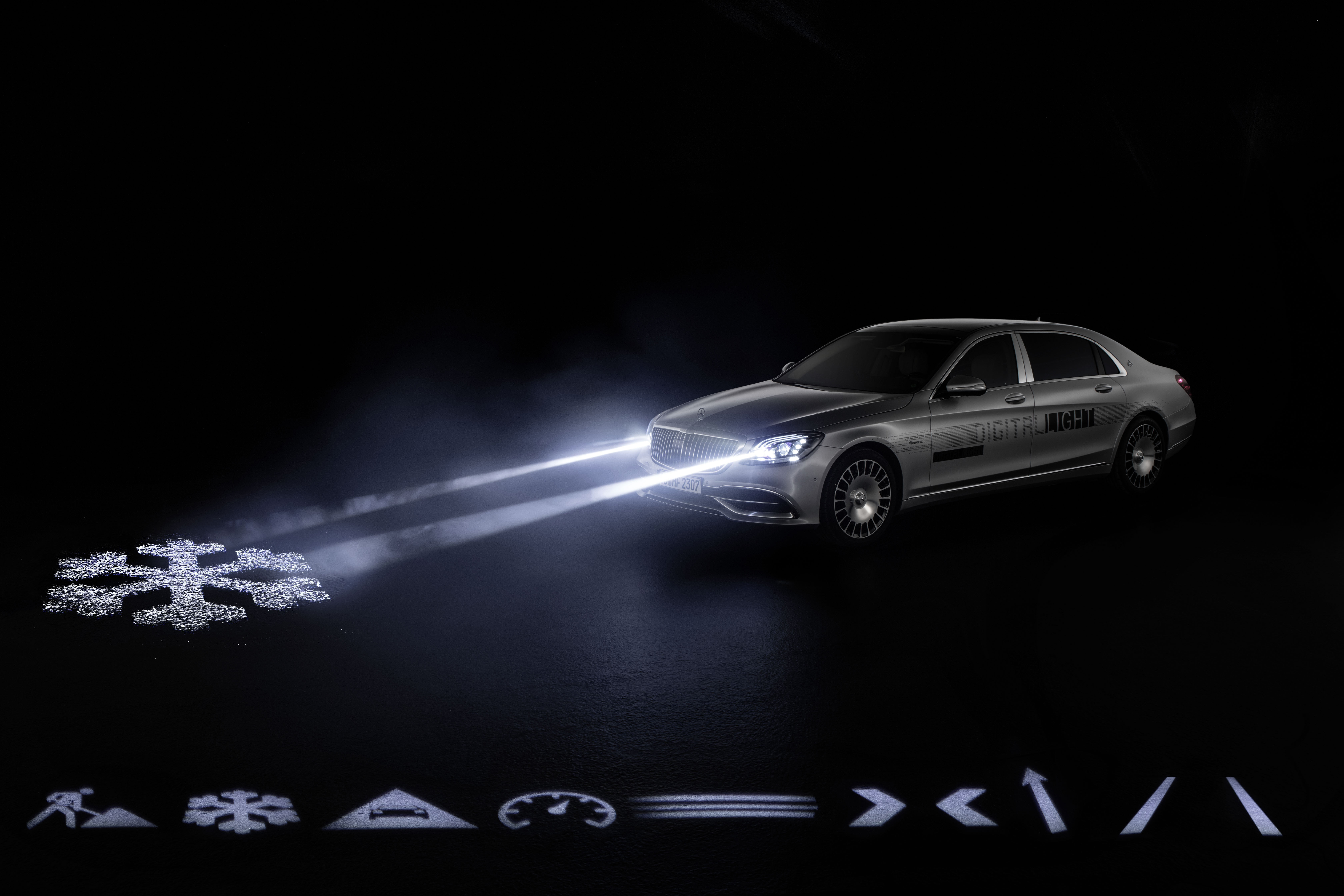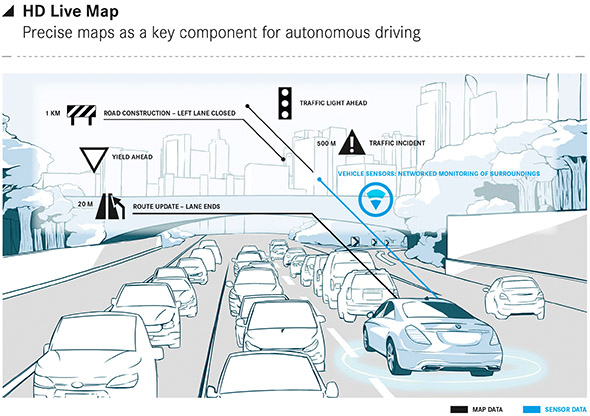TSA Trailer Stability Assist

The technology: How Trailer Stability Assist works
- Fishtailing is detected and countered swiftly
- ESP® Electronic Stability Program forms the basis
- Trailer is sensed automatically
An undulation in the road, a gust of wind from the side or simply changing lane, any one of these factors can be enough to set the trailer swerving from side to side. Generally, this motion will subside of its own accord – provided that the road speed is below the critical threshold, as it is known.
At higher speeds, this is no longer the case, however, with the oscillating motion building up spontaneously until the driver ultimately loses control of vehicle and trailer. This is why it is so important to detect this oscillating motion as early as possible and counteract it before handling becomes unmanageable, with the threat of serious consequences.
TSA is an extra function of the ESP® Electronic Stability Program and shares its sensory system; no additional electronics are required for either the trailer or the trailer coupling. TSA works as follows: the sideways movements of the destabilised trailer are transmitted to the vehicle towing it, which in turn starts to swerve from side to side.
TSA detects this as a yaw motion around the vehicle’s vertical axis and initiates countermeasures in response. The oscillating motion is subdued actively by applying the brakes at the front left and right wheels of the towing vehicle individually and alternately. In the majority of cases, this is sufficient to eliminate the weaving motion completely, and with it the threat of danger, whilst only causing a slight drop in road speed.
Two-stage operation
If, on the other hand, the degree of fishtailing is very severe or the critical speed has already been exceeded, an additional control level takes effect: in order to bring the speed below the critical range as quickly as possible, TSA reduces the road speed more sharply by throttling the engine torque of the towing vehicle as well as building up brake pressure at all four wheels, instead of just applying the brakes at the front wheels individually.
When this second control stage is activated, the brake lights come on to warn vehicles behind in exactly the same way they would if the driver braked to bring the outfit under control.
The fact that Mercedes-Benz Trailer Stability Assist operates sensitively and in two stages represents a dual benefit: TSA counters oscillating motion at an incipient stage before it becomes critical and is often able to bring it under control merely by means of gentle, corrective brake applications at the front wheels. TSA will only adjust the vehicle’s speed if additional braking is imperative for stabilising vehicle and trailer – the result is added comfort for driver and passengers alike.
Electronic course correction
To enable the system to function correctly, it is important that the driver keeps firm hold of the steering wheel when fishtailing occurs and does not attempt to countersteer. This enables TSA to establish that the driver would like to maintain the present course, as TSA compares the current vehicle heading with the heading corresponding to the steering wheel angle in the same way as ESP® does; if there is a discrepancy between the two, the electronics take the necessary action to bring the vehicle, or rather the vehicle/trailer outfit, back on course.
The ESP® warning lamp in the dashboard lights up to inform the driver when TSA takes corrective action. Incidentally, the ESP® system continues to take priority, meaning that its corrective brake commands can override those of TSA at any time. ESP® must of course be switched on for TSA to take action.
Trailer Stability Assist from Mercedes-Benz actively boosts safety when towing a trailer by eliminating any weaving motion in the towing vehicle and trailer. TSA detects that a trailer has been hitched to the vehicle when the trailer’s electrical connector is joined up.
TSA operates in the same way regardless of the trailer being towed. It is also capable of stabilising small trailers, with the sole proviso that their total weight is sufficient to cause the vehicle towing them to swing from side to side.
Cannot change the laws of physics
TSA is able to increase safety within the bounds of the laws of physics, but it is not able to nullify those laws. Consequently, the following limitations apply:
- If the fishtailing vehicle/trailer combination is quite simply being driven at an irresponsible speed, the resulting forces may exceed the technology’s limits.
- If the driver causes the vehicle and trailer to start fishtailing by making constant steering adjustments, TSA will be unable to take corrective action, as the instability will have been caused by the driver steering and not by the trailer.
- If drivers change lane extremely abruptly, the trailer can jack-knife as a result of the first sudden swerve. This is beyond even the high-speed corrective capabilities of TSA.
- If the towing vehicle is travelling too fast, small trailers may start to skip along behind it. As this vertical motion does not affect the towing vehicle’s yaw characteristics in any way, however, TSA is unable to counteract it.
- Equally, TSA is unable to prevent a trailer that is carrying an excessively high or poorly distributed load from tipping over.
Knowing right from wrong: Legal tips
· 100 km/h gets you from A to B quicker
· Is a driving licence all that is needed to tow a trailer?
· Driving abroad
Trailer towing is subject to its own set of legal regulations. It is important to be aware of these regulations, especially as some of them are of practical benefit.
The quickest way from A to B – approval for the 100 km/h limit
Approved trailers may be towed at a maximum speed of 100 km/h instead of 80 km/h in Germany provided that certain conditions are fulfilled.
· The car must be equipped with an anti-lock braking system (ABS).
· The tyres on the trailer must be designed for a speed of at least 120 km/h and must be less than six years old.
· If the trailer is equipped with an overrun brake and hydraulic shock absorbers, its maximum gross vehicle weight may be no greater than 110 percent of the towing vehicle’s kerb weight. On a passenger car with a kerb weight of 1000 kilograms, for example, this means no more than 1100 kilograms. In the case of caravans, the limit is 80 percent.
· The 100 km/h speed limit also applies to small, unbraked trailers and trailers without hydraulic shock absorbers provided that they are fitted with suitable tyres and their maximum gross weight does not exceed 30 percent of the towing vehicle’s kerb weight. In other words, a towing vehicle with a kerb weight of at least 2000 kilograms is required to tow a small 600-kilogram trailer at this speed.
· A recognised technical inspection authority (such as TÜV) checks that towing vehicle and trailer meet the specified requirements. If so, two 100 km/h badges will be issued to affix to car and trailer.
Different speed limits may apply for trailer towing in other countries.
Driving licence regulations
Not every driving licence entitles the holder to tow a trailer with a car – care must be taken to heed the regulations in each country.
In the European Union (EU), the status quo since the most recent reform of driving licence law and the introduction of the EU driving licence is as follows: anyone who obtained their driving licence under the old law (category 3) may continue to hitch up trailers to their car with a GVW of up to 3.5 tonnes without any further ado. The car/trailer outfit may have no more than three axles however, with tandem axles – i.e. two axles spaced less than one metre apart – counting as a single axle. If the distance is greater than one metre, the trailer is considered to be a twin-axle trailer which requires on old category 2 driving licence.
The situation is somewhat different for holders of the new standardised passenger car driving licence (category B) who do not have the additional trailer towing entitlement (category E): although such a licence entitles the holder to drive any motor vehicle up to gross vehicle weight of 3.5 tonnes, by no means does it permit them to tow all trailers. If the EU driving licence only indicates category “B” and not “BE” therefore, the following two rules apply:
· Any trailer up to a maximum gross vehicle weight of 750 kilograms may be towed.
· If a heavier trailer is to be towed: firstly, the trailer’s maximum gross weight may not exceed the towing vehicle’s kerb weight and secondly, the maximum gross weight of passenger car and trailer combined may not exceed the 3.5-tonne limit.
If either of these limits is passed, a category BE driving licence will be required. To be on the safe side, this is always the best licence to have. It is not difficult to obtain and anyone currently preparing for their driving test ought to think about applying for the additional entitlement at the same time.
The removable trailer coupling
On vehicles fitted with a removable trailer coupling, the coupling must be removed whenever it is not in use. This regulation applies in all European countries and has been prompted partly by liability issues: if someone suffers an injury or damage which would not have occurred had the trailer coupling not been fitted, the vehicle owner is held liable in most cases.
Driving abroad
Anyone driving with a trailer abroad must take care to observe the specific regulations that apply in a good many countries.
· Maximum speed: the maximum national speed limit for vehicles towing a trailer applies in all cases. In Italy, for example, the speed limit is always 80 km/h which also applies to car/trailer outfits which are authorised to travel at 100 km/h in Germany. If speeds in excess of 100 km/h are allowed – such as in France where the speed limit on the motorway is 130 km/h – drivers can expect to encounter insurance problems if they suffer an accident at this speed while towing a trailer that is only approved for 80 km/h or 100 km/h.
· Italy: a new regulation has now come into force which stipulates that any load projecting beyond the rear end of the vehicle must be clearly marked by means of a warning plate (standard red-and-white striped plate measuring at least 50 x 50 centimetres in size). Anyone who fits a bicycle carrier to the rear of the trailer, for example, needs to attach such a plate. And it is also needed when the bicycles are transported to the destination on a rear-mounted carrier positioned between car and trailer, but the trailer is then unhitched at the destination and the vehicle continues to be driven with the carrier attached.
· Netherlands: an equipment regulation applies in the Netherlands which police checking vehicles occasionally try to apply to car/trailer outfits from abroad. They are wrong to do this however: an outfit that is registered in accordance with the laws of another country must be granted transit without any objection. The equipment regulation in question reads as follows: smaller trailers without their own brake whose maximum gross vehicle weight does not exceed 1.5 tonnes are required to be fitted with a break-away safeguard device to prevent the trailer becoming detached from the towing vehicle unnoticed. A tear-away brake cable which acts on the trailer’s handbrake is prescribed for heavier trailers with a maximum gross vehicle weight of over 1.5 tonnes and a separate trailer brake.
· Switzerland: trailers towed on the Swiss autobahn require a separate vignette.
· Spain: any load projecting beyond the end of the vehicle must be clearly marked by means of a red-and-white striped warning plate measuring at least 50 x 50 centimetres in size.


